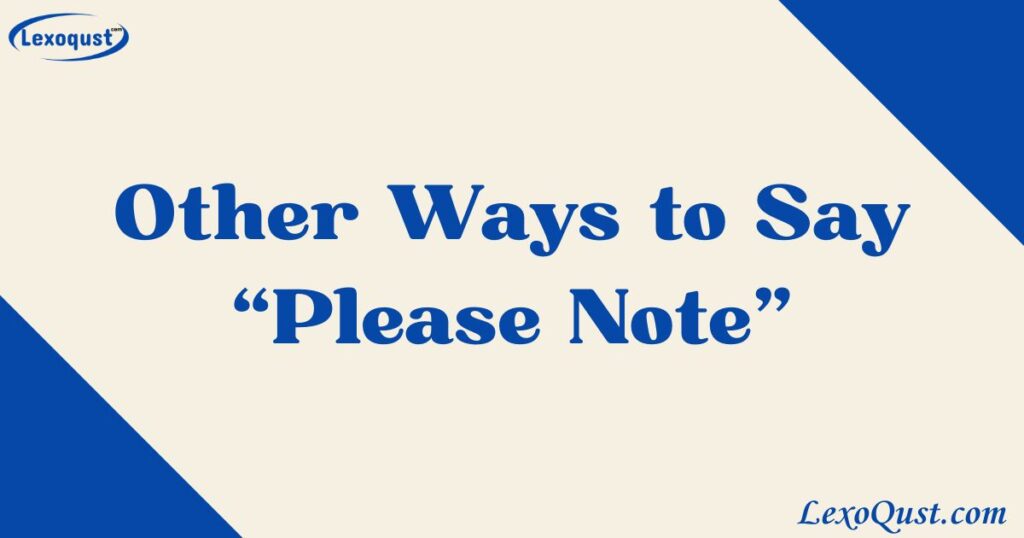Choosing the right words can instantly improve the way your message is received. Whether you’re writing an essay, preparing a formal report, or sending a personal letter, tone and clarity are key. Strong communication depends on word choice, and using phrases that feel too stiff can sometimes create distance between you and your reader.
A great example is the phrase “please note.” While it’s commonly used, it can come across as overly formal or cold. Swapping it out for something more thoughtful—like “Kindly be aware” or “Just a quick reminder” can help your writing sound more inviting and human.
In this post, you’ll discover 33+ alternative ways to say “please note” that add warmth, clarity, and a touch of personality to your writing. These phrases are perfect for enhancing tone, building connection, and making your communication more effective across any context.
What Does “Please Note” Mean?
“Please note” is a polite phrase used to draw the reader’s attention to important information. It signals that what follows is worth noticing or remembering, especially in formal writing, instructions, or updates. The tone is typically neutral to formal, depending on context.
When to Use “Please Note”
Use “please note” when highlighting deadlines, policy changes, instructions, or clarifications in emails, reports, notices, or academic writing. It helps emphasize key points without sounding forceful, ensuring the reader doesn’t overlook critical information.
Is It Professional/Polite to Say “Please Note”?
Yes, “please note” is considered both professional and polite, but it can feel overly formal or repetitive if used too often. For more natural tone or softer delivery, use alternatives like “Kindly be aware”, “Just so you know”, or “We’d like to highlight.”
1. “Kindly Be Aware”
Meaning: A courteous way to highlight something important.
Definition: Politely notifies the reader of relevant or upcoming information.
Tone: Respectful, formal, and considerate.
Example: Kindly be aware that the meeting time has changed to 3 PM.
Explanation: This phrase adds a touch of warmth while signaling key information, showing empathy for the reader’s need to stay informed.
Purpose & Personalization: Use to maintain a professional yet gentle tone. For informal writing, consider “Just so you know” for a softer feel.
2. “Just a Reminder”
Meaning: A friendly nudge about something already mentioned.
Definition: Briefly reaffirms known information or actions expected.
Tone: Casual, helpful, and supportive.
Example: Just a reminder that your assignment is due tomorrow.
Explanation: It avoids sounding demanding while keeping the reader on track.
Purpose & Personalization: Great for friendly or team-based communication. Swap with “As a gentle reminder” if you want extra softness.
3. “Please Be Informed”
Meaning: A formal notice about something factual or official.
Definition: Alerts the reader to a fact or status update.
Tone: Professional, direct, and clear.
Example: Please be informed that the office will be closed on Monday.
Explanation: It conveys authority and is ideal in professional or administrative writing.
Purpose & Personalization: Best for policies or announcements. Use alternatives like “We’d like to inform you” to soften it slightly.
4. “I’d Like to Draw Your Attention To”
Meaning: Directs focus to a specific detail or section.
Definition: Signals that what follows deserves careful review.
Tone: Direct yet polite.
Example: I’d like to draw your attention to section 3 of the report.
Explanation: Encourages focus without sounding demanding, making it reader-friendly.
Purpose & Personalization: Suitable for formal or instructional writing. Adjust tone by shortening to “Take a look at…” in casual settings.
5. “Please Take Note”
Meaning: A courteous command to remember or consider something.
Definition: Marks information as important or actionable.
Tone: Neutral to slightly formal.
Example: Please take note of the new safety procedures.
Explanation: Offers clarity and importance without being too harsh.
Purpose & Personalization: Best for alerts or changes. Use “Just so you know” for a lighter tone in casual texts.
6. “I’d Like to Bring to Your Attention”
Meaning: A polite cue to consider something significant.
Definition: Introduces important information or potential issues.
Tone: Respectful and formal.
Example: I’d like to bring to your attention a discrepancy in the data.
Explanation: Shows professionalism while inviting the reader to take notice.
Purpose & Personalization: Effective in business or collaborative writing. Simplify to “I noticed…” in personal correspondence.
7. “As a Heads-Up”
Meaning: A casual advance notice of something upcoming or unexpected.
Definition: Warns or informs the reader in advance.
Tone: Friendly and informal.
Example: As a heads-up, the platform will undergo maintenance tonight.
Explanation: Builds trust by keeping readers in the loop.
Purpose & Personalization: Ideal for internal updates. Use “For your awareness” if you need a more neutral tone.
8. “I’d Appreciate Your Attention to”
Meaning: A respectful request for the reader to focus on something.
Definition: Politely asks for awareness or action.
Tone: Gracious and slightly formal.
Example: I’d appreciate your attention to the upcoming changes in policy.
Explanation: Combines politeness with purpose, showing appreciation for the reader’s time.
Purpose & Personalization: Use when collaboration or respect is key. Soften to “Thanks for checking out…” in friendly writing.
9. “It’s Important to Note”
Meaning: Emphasizes a critical detail that should not be ignored.
Definition: Calls attention to something essential.
Tone: Assertive yet composed.
Example: It’s important to note that only verified users can access this feature.
Explanation: Adds weight to the message without sounding harsh.
Purpose & Personalization: Use in explanations or policy reminders. For softer tone, say “Worth noting…”
10. “For Your Awareness”
Meaning: Gives information without requiring action.
Definition: Shares a fact to keep the reader informed.
Tone: Informative and neutral.
Example: For your awareness, the system will be offline at midnight.
Explanation: Keeps communication transparent and proactive.
Purpose & Personalization: Great for status updates. Replace “Just FYI” in casual notes.
11. “I Would Like to Mention”
Meaning: A gentle way to introduce a thought or detail.
Definition: Politely adds extra information.
Tone: Thoughtful and approachable.
Example: I would like to mention that feedback is due next Friday.
Explanation: Feels conversational, not commanding—ideal for subtle cues.
Purpose & Personalization: Use to maintain politeness. Consider “Just to add…” for informal contexts.
12. “Please Keep in Mind”
Meaning: Encourages the reader to remember or consider something.
Definition: Suggests that the reader retain key info for future use.
Tone: Considerate and balanced.
Example: Please keep in mind that the deadline has moved up.
Explanation: Helps avoid confusion without sounding harsh.
Purpose & Personalization: Useful for scheduling or planning reminders. Swap with “Remember that…” in casual text.
13. “May I Draw Your Attention To”
Meaning: A polite request to notice or consider something.
Definition: Invites awareness without demanding it.
Tone: Formal and respectful.
Example: May I draw your attention to the updated terms?
Explanation: Encourages focus while preserving a courteous tone.
Purpose & Personalization: Ideal in formal writing. Try “Quick heads-up” for friendlier notes.
14. “Let Me Highlight”
Meaning: Brings attention to a detail or key takeaway.
Definition: Clearly emphasizes specific content.
Tone: Confident and helpful.
Example: Let me highlight a few key benefits of the proposal.
Explanation: Useful when you want clarity without sounding too forceful.
Purpose & Personalization: Works well in explanations or summaries. For softer delivery, try “Here’s something worth noting…”
15. “It’s Worth Noting”
Meaning: Points out information that may add value or context.
Definition: Suggests something is helpful or significant to remember.
Tone: Reflective and considerate.
Example: It’s worth noting that our approach aligns with industry trends.
Explanation: Adds insight without pressure, ideal for persuasive writing.
Purpose & Personalization: Effective in thought leadership or informative pieces. Use “Just something to think about…” in casual tones.
16. “Just So You Know”
Meaning: Used to casually introduce helpful or relevant information.
Definition: A gentle way to provide notice or context.
Tone: Friendly and informal.
Example: Just so you know, the deadline has been extended to Friday.
Explanation: This phrase feels like a friendly heads-up, helping the reader feel informed without pressure.
Purpose and Personalization: Ideal for casual writing or conversational tones. Personalize by pairing it with positive or neutral facts to keep communication approachable.
17. “Allow Me to Inform You”
Meaning: A formal phrase introducing important details or updates.
Definition: Grants permission to share information in a courteous way.
Tone: Polite and professional.
Example: Allow me to inform you that the policy has recently changed.
Explanation: It respects the reader while guiding attention to a key point.
Purpose and Personalization: Use in formal settings like reports or official messages. Adjust for tone by using simpler phrasing in casual writing.
18. “I Wish to Point Out”
Meaning: Signals a desire to bring specific details to the reader’s attention.
Definition: Indicates that the writer finds the information worth emphasizing.
Tone: Respectful and intentional.
Example: I wish to point out that your proposal meets all criteria.
Explanation: Shows deliberate focus, reflecting the writer’s careful thought.
Purpose and Personalization: Great for emphasizing appreciation or concern. You can make it more conversational with alternatives like “Just wanted to highlight.”
19. “I’d Like to Alert You To”
Meaning: Warns or informs the reader about something potentially important.
Definition: Shares critical info with a sense of responsibility or urgency.
Tone: Cautious and concerned.
Example: I’d like to alert you to a possible error in the document.
Explanation: Suggests care for the reader’s success or awareness.
Purpose and Personalization: Best for pointing out risks or changes. Use softer alternatives in casual writing like “Heads-up about…”
20. “For Your Consideration”
Meaning: Offers information or suggestions for thoughtful review.
Definition: Invites the reader to reflect on a presented idea or fact.
Tone: Thoughtful and respectful.
Example: For your consideration, I’ve included an alternative timeline.
Explanation: Encourages dialogue while respecting the reader’s input.
Purpose and Personalization: Useful in collaborative writing. Personalize it by pairing with opinions or recommendations.
Learn More: Other Ways to Say “I will Do My Best”
21. “Take Note”
Meaning: Urges the reader to pay special attention to something.
Definition: A direct instruction to be aware of key information.
Tone: Assertive and clear.
Example: Take note of the revised meeting location.
Explanation: Its brevity ensures clarity and focus.
Purpose and Personalization: Ideal for urgent updates. In softer writing, use “Just a quick note” to keep it less commanding.
22. “I Would Like to Clarify”
Meaning: Introduces a correction or explanation to prevent misunderstanding.
Definition: Expresses intent to provide clearer insight or fix confusion.
Tone: Helpful and transparent.
Example: I would like to clarify that this offer expires on July 5th.
Explanation: Shows care for accuracy and reader understanding.
Purpose and Personalization: Best in formal or factual content. You can adjust to “Just to clarify” for a more casual tone.
23. “Please Be Advised”
Meaning: Formally informs someone of important information or actions.
Definition: A standard notice phrase used in professional or legal contexts.
Tone: Formal and informative.
Example: Please be advised that the office will be closed Monday.
Explanation: Communicates authority and responsibility.
Purpose and Personalization: Use in structured writing or policy notices. For softer use, try “Just so you know.”
24. “It’s Crucial to Remember”
Meaning: Emphasizes the importance of retaining or acting on certain info.
Definition: Highlights that the following point is essential.
Tone: Urgent and sincere.
Example: It’s crucial to remember to submit your form before Friday.
Explanation: Appeals to responsibility and consequence.
Purpose and Personalization: Great for reminders with deadlines. In softer writing, change to “It’s helpful to keep in mind.”
25. “I Want to Ensure You Are Aware”
Meaning: Introduces information to confirm the reader’s understanding.
Definition: Indicates the writer’s intent to share knowledge to avoid confusion.
Tone: Supportive and clear.
Example: I want to ensure you are aware of the updated criteria.
Explanation: Builds trust by showing consideration.
Purpose and Personalization: Best for guiding or instructive writing. Personalize by making it conversational: “Just making sure you know.”
26. “Please Be Sure”
Meaning: Encourages the reader to confirm or double-check something.
Definition: A polite prompt to verify or complete an action.
Tone: Encouraging and careful.
Example: Please be sure to include your name on the form.
Explanation: It sounds respectful while prompting follow-through.
Purpose and Personalization: Great in reminders or instructions. Adjust to “Make sure to” in casual writing.
27. “I’d Like to Make You Aware”
Meaning: Gently notifies the reader of useful or relevant information.
Definition: Politely introduces new details.
Tone: Considerate and calm.
Example: I’d like to make you aware of a schedule change.
Explanation: Smooth and reader-first, it avoids sounding abrupt.
Purpose and Personalization: Perfect for polite notices. In friendly writing, try “Just wanted to let you know.”
28. “I Just Want to Ensure”
Meaning: Expresses a desire to confirm something clearly and kindly.
Definition: Communicates a final check or clarification.
Tone: Thoughtful and reassuring.
Example: I just want to ensure everything is on track for Monday.
Explanation: Reduces confusion while offering support.
Purpose and Personalization: Good for teamwork or follow-ups. You can shift to “Just checking in” for a relaxed tone.
Learn More: Other Ways to Say “will Do”
29. “Please Keep in Mind”
Meaning: A soft reminder about an important detail.
Definition: Politely requests attention or memory retention.
Tone: Friendly and helpful.
Example: Please keep in mind the office hours have changed.
Explanation: Keeps the tone gentle while reinforcing a point.
Purpose and Personalization: Great for educational or customer messages. Use “Keep in mind” for a more informal voice.
30. “Let Me Point Out”
Meaning: Signals that the writer wants to highlight something specific.
Definition: Used to direct attention to notable or often overlooked info.
Tone: Direct and respectful.
Example: Let me point out that this solution saves both time and cost.
Explanation: Encourages awareness while keeping a personal touch.
Purpose and Personalization: Excellent in persuasive writing. Personalize with “Just want to highlight” for a lighter tone.
31. “A Quick Note to Mention”
Meaning: A light, polite way to introduce useful information or a reminder.
Definition: Signals a brief point that deserves attention.
Tone: Casual and friendly.
Example: A quick note to mention—registration closes tomorrow.
Explanation: It sets a non-intrusive tone while still being informative.
Purpose and Personalization: Perfect for emails or newsletters. Adjust by making it more formal like “Please be advised” when needed.
32. “You Might Find It Helpful to Know”
Meaning: Suggests that the following information will benefit the reader.
Definition: Offers insight or updates with consideration for the reader’s needs.
Tone: Supportive and thoughtful.
Example: You might find it helpful to know the form has been simplified.
Explanation: Shows empathy by framing the message around usefulness.
Purpose and Personalization: Great for instructional or customer-focused writing. You can shorten it to “Helpful tip:” for a punchier tone.
33. “As a Heads-Up”
Meaning: Gives early notice about something upcoming or important.
Definition: A casual alert that helps prepare the reader in advance.
Tone: Relaxed and proactive.
Example: As a heads-up, the system will be down for maintenance tonight.
Explanation: Builds reader trust by anticipating their needs.
Purpose and Personalization: Ideal for updates or scheduling notes. In formal settings, swap with “Please note” or “Be advised.”
34. “Let’s Not Forget”
Meaning: Encourages the reader to remember something important.
Definition: A collaborative reminder to maintain awareness.
Tone: Encouraging and inclusive.
Example: Let’s not forget the submission deadline is this Friday.
Explanation: It promotes a sense of teamwork or shared responsibility.
Purpose and Personalization: Use in team messages or blogs. Personalize further with context: “Let’s not forget the reason behind this change.”
35. “This Is Just to Inform You”
Meaning: Offers clear notification without emotional weight.
Definition: States facts or updates directly and neutrally.
Tone: Objective and straightforward.
Example: This is just to inform you that your subscription renews next week.
Explanation: Useful for clarity in transactional or service communications.
Purpose and Personalization: Best in formal emails or system alerts. Soften tone by saying, “Just letting you know.”
Conclusion
Choosing the right words like finding other ways to say “please note”—can truly transform your writing. Thoughtful language helps build clarity, connection, and credibility, whether you’re crafting a blog post, academic paper, or heartfelt letter. I encourage you to explore these alternatives and make your voice more engaging and reader-friendly.
These simple shifts add warmth, professionalism, and personality to any message. I created this guide to support writers like you in expressing ideas with purpose and authenticity. Now it’s your turn—start using these meaningful phrases and let your writing leave a lasting impression. You’ve got this!

Hi! I’m Amelia Ashford, the admin of Lexoqust.com. Here, we dive deep into the world of synonyms to help you express yourself better.From everyday words to advanced vocabulary, Lexoqust makes your writing richer and more refined.



